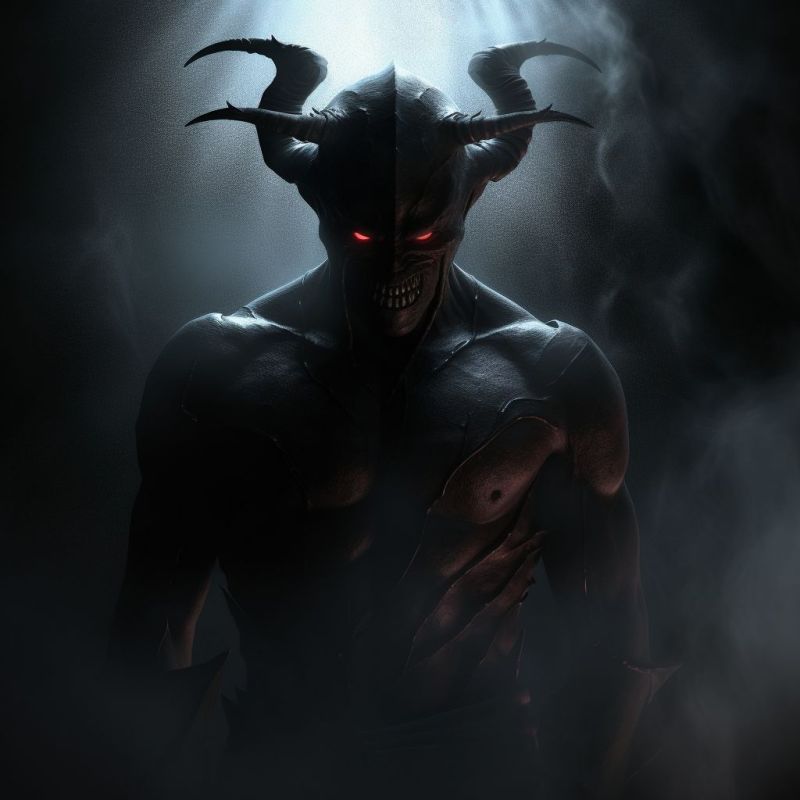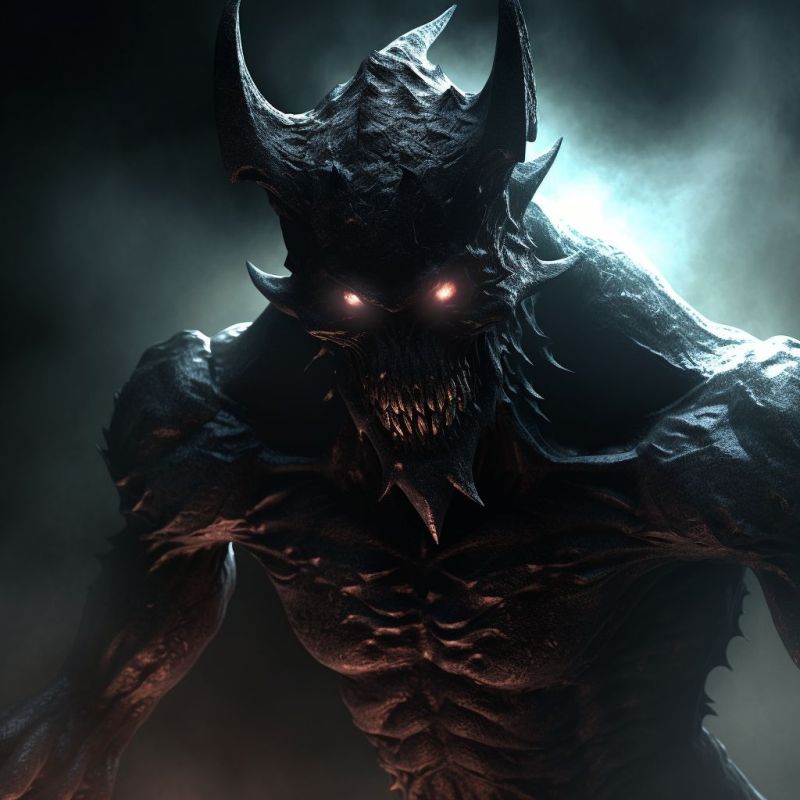 Natural Weapon(s):
Natural Weapon(s):-
Claw (2d6)
 Passive Abilities:
Passive Abilities:-
Sunlight Sensitivity-1000 gp
 Quick Abilities:
Quick Abilities:-
Shadow Hide500 gp
You see the Shadow Demon materialize, its form shifting and swirling like living darkness. Its red eyes glow menacingly, and its clawed hands extend from the inky void, ready to strike with ethereal, otherworldly force.
When a malevolent presence or sinister notion is vanquished, remnants sometimes endure, coalescing anew within the embrace of The Darkness.
This residual essence manifests as a shadow demon, akin to a specter haunting the very locus where the malevolence once festered, driven by an unyielding thirst to see its sinister purpose realized.
👻💨 Apparitions: Spectral Heralds of Decay and Despair
Apparitions are vengeful spirits, tethered to the mortal realm by unresolved grievances and seething resentment. 🌫️ These spectral entities drift through the world, their translucent forms radiating an aura of rot and ruin that withers life and beckons the undead. Driven by unfinished business and fueled by rage, they are both a haunting tragedy and a deadly menace, their presence chilling the soul as surely as it blights the land. In any campaign, apparitions are poignant and perilous, their lingering emotions and decaying influence weaving tales of sorrow, vengeance, and redemption.
🕳️ Ethereal Form: Twisted Echoes of Life
Apparitions manifest as ghostly figures, their translucent bodies shimmering with an eerie, sickly glow. 🖤 Often, they resemble their living selves, but their forms are warped by resentment—eyes burning with malice, features contorted in anguish, or limbs trailing into wisps of shadow. A knight’s apparition might clutch a spectral blade, while a betrayed lover’s form drips with illusory tears. Their ethereal nature allows them to glide through walls and hover above the ground, untouchable by mundane weapons yet vulnerable to holy light or radiant magic that sears their corrupted essence.
Game Masters can tailor an apparition’s appearance to reflect its story—a merchant with coins spilling from spectral wounds, or a child clutching a broken toy. Their visual distinctiveness sets the tone for encounters, hinting at the emotions and events that bind them.
🌿 Signs of Decay: Blight of the Spectral Wake
Wherever an apparition lingers, the world sickens. 🌑 Plants wither to brittle husks, wood warps and rots, and the air turns cold and heavy with a stagnant, graveyard chill. This tangible aura of decay is unmistakable, marking their haunts with blackened earth or crumbling stone. The presence of an apparition draws undead—shambling zombies or wailing spirits—amplifying the danger of their domain, while living creatures suffer, their vitality sapped by the oppressive miasma.
GMs can use these signs to build dread, with players noticing wilting crops or rancid water as clues to an apparition’s influence. The decay can escalate with the apparition’s rage, turning a haunted manor into a rotting labyrinth or a village into a necrotic wasteland, creating dynamic environments for exploration or combat.
🗝️ Unfinished Business: Anchors of the Soul
Apparitions are bound by unresolved tasks from their lives, their spectral existence a desperate bid to complete what death denied them. ⚖️ A warrior might seek vengeance for a betrayal, haunting their killer’s lineage; a guardian might protect a lost treasure, unable to rest until it’s safe; a parent might linger to fulfill a broken promise to a child. These goals drive their actions, and resolving them—through aid, trickery, or force—can lay an apparition to rest, freeing its soul from torment.
Understanding an apparition’s purpose is key to confronting it. Some can be reasoned with, their rage soothed by fulfilling their desires, while others are too consumed by hatred to negotiate. GMs can craft unique tasks tied to the campaign’s lore—a forgotten oath to a fallen god, or a love letter never delivered—making each apparition a narrative puzzle that rewards empathy or cunning.
⚔️ Resentment and Rage: Fury of the Forsaken
An apparition’s heart burns with intense emotions—grief, betrayal, or unquenched wrath—that fuel its spectral might. 😡 In combat, they unleash this rage, hurling necrotic blasts, draining life with a chilling touch, or summoning decayed remnants of their past to fight. Their ethereal forms shrug off physical blows and necrotic forces, but holy relics, radiant spells, or artifacts tied to their life—like a betrayer’s dagger or a lover’s locket—can pierce their defenses, unraveling their essence.
Their emotions also shape their behavior. A sorrowful apparition might plead for aid, while a vengeful one hunts relentlessly. Players who discern these feelings—through investigation or magic—can turn the tide, calming the spirit with empathy or provoking it to reckless fury. GMs can use this emotional core to create dynamic encounters, where combat blends with roleplay, and understanding the apparition’s pain becomes as crucial as striking it down.
🌌 Shadows of a Shattered Past
Apparitions are more than spectral foes; they are echoes of lives left incomplete, their decay a mirror to their inner torment. 🖌️ In a campaign, they serve as haunting mysteries, their haunts revealing forgotten sins or buried truths. Players might aid an apparition to free a cursed village, battle one to claim its guarded relic, or uncover its story to prevent a greater evil. Their origins can anchor to any setting—a scorned priest in a desecrated temple, a sailor lost to a storm-haunted reef, or a rebel executed in a tyrant’s dungeon—offering GMs endless ways to enrich their world.
In realms like Zin, where ancient grudges linger, apparitions might drift through war-scarred ruins, their rot seeping into the land’s wounds. To face an apparition is to grapple with the past’s weight, a challenge that tests compassion as much as courage. Heroes who resolve an apparition’s pain may bring peace to a haunted place, but those who falter risk falling to the decay that follows in its wake, forever marked by the specter’s wrath. 👁️🗨️
 Special Senses:
Special Senses:-
 Nightsight: +60
Nightsight: +60
-
 Ghostsight: +60
Ghostsight: +60
 Damage Type Immunity:
Damage Type Immunity:-
 Cold
Cold -
 Necrotic
Necrotic
 Damage Type Vulnerability:
Damage Type Vulnerability:-
 Radiant
Radiant
 Immune to Status Effect:
Immune to Status Effect:-
 Bleeding (2d6)
Bleeding (2d6) -
 Charmed
Charmed -
 Chilled
Chilled -
 Freezing
Freezing -
 Frightened
Frightened -
 Frozen
Frozen -
 Grappled
Grappled -
 Grappling
Grappling -
 Immobile
Immobile -
 Paralyzed
Paralyzed -
 Petrified
Petrified -
 Prone
Prone -
 Restrained
Restrained -
 Sleeping
Sleeping -
 Starving
Starving -
 Suffocating
Suffocating
 Persistant/Permanent Status Effect:
Persistant/Permanent Status Effect:-
 Incorporeal
Incorporeal
-
 Damage Mitigation:
+2
Damage Mitigation:
+2
😈🌪️ Demons: Abyssal Harbingers of Chaos
Demons are the raw, untamed essence of destruction, spawned in the roiling chaos of the Infinite Layers of the Abyss. 🕳️ These malevolent fiends are the embodiment of anarchy, their monstrous forms barely containing the seething energies of madness and ruin. From the lowliest dretch to the cataclysmic balor, demons surge forth as relentless agents of mayhem, driven by an insatiable urge to corrupt, defile, and annihilate. In any campaign, they are the ultimate force of disorder, their presence a storm that threatens to unravel the fabric of existence itself.
🌑 Unveiling the Abyssal Horrors: Origins of Chaos
Demons are born in the darkest depths of creation, where reality frays into a nightmare of endless turmoil. 🌀 The Abyss, a plane of infinite, ever-shifting layers, is their crucible, each layer a twisted reflection of chaos’s boundless nature. Here, demons emerge not from flesh but from the raw stuff of malevolence, their forms sculpted by the Abyss’s capricious will. They are the antithesis of order, their existence a rebellion against structure, harmony, and life itself, making them harbingers of doom in any world they invade.
Game Masters can root demons in their campaign’s cosmology—perhaps the Abyss is a wound in reality, a god’s shattered dream, or a prison for primal evils. Their origins offer flexibility, allowing demons to serve as cosmic threats, local terrors, or the fallout of a failed ritual.
🧬 Soulforge of the Abyss: Twisted Mortal Spirits
Demons are not born but forged, their essence drawn from mortal souls condemned to the Abyss’s torment. 🖤 These souls, stripped of their humanity, are those who in life embraced chaos—bandits who reveled in lawlessness, tyrants who sowed discord, or dreamers consumed by hateful obsessions. In the Abyss, they are unmade and remade, their spirits warped into nightmarish forms that reflect their sins: a glutton’s soul bloated into a gibbering dretch, a warrior’s rage forged into a hulking hezrou. This transformation severs all ties to their mortal past, leaving only a creature of pure, destructive instinct.
GMs can use this transformation to add depth—perhaps a demon retains a flicker of its mortal life, a vulnerability heroes can exploit, or a campaign hinges on preventing a soul’s descent into demonic rebirth. The process grounds demons in mortal folly, making their horror all the more personal.
🗡️ Wayward Believers: Champions of Anarchy
The souls that become demons were often those who rejected order in life, embracing the freedom of chaos or the power of destruction. 🩸 Some were anarchists who burned cities to ash, others philosophers who saw morality as a cage. Their beliefs, twisted by malice, drew them to the Abyss, where their ideals were distilled into pure malevolence. Even hateful thoughts—envy, wrath, despair—can coalesce into demonic forms, birthed from the collective darkness of mortal minds.
This origin allows GMs to craft demons that mirror their world’s conflicts. A setting plagued by rebellion might spawn demons of defiance, while one steeped in betrayal breeds fiends of deceit. Their mortal roots make them relatable yet alien, a twisted reflection of the campaign’s themes.
🦂 Varieties of Demonic Malevolence: A Legion of Terrors
Demons are as diverse as the chaos they embody, their forms a grotesque gallery of horror. 🕷️ Dretches shuffle as mindless, oozing wretches, while quasits skitter as venomous tricksters. Vrocks swoop with vulture-like savagery, and glabrezu tempt with honeyed lies and crushing claws. At the apex stand balors, towering infernos of rage whose mere presence scorches the earth. Each demon is a unique nightmare, its abilities—claws, venom, psychic screams, or reality-warping magic—reflecting the Abyss’s boundless creativity.
GMs can tailor demons to any encounter, from swarms of lesser fiends overwhelming a village to a single marilith cutting through armies with her bladed dance. Their variety ensures no two demonic threats feel the same, keeping players on edge.
👑 The Infernal Hierarchy: Lords of the Abyss
Amid the Abyss’s chaos, a brutal hierarchy reigns, crowned by the Demon Lords—beings of unfathomable power and cruelty. 🧠 Each lord rules a layer of the Abyss, from Demogorgon’s twin-headed madness to Orcus’s necromantic dominion. These titans command legions of lesser demons, their schemes shaking the multiverse as they war against each other and the forces of good. Their cunning rivals their might, weaving plots that span planes, their influence corrupting mortals and fiends alike.
Game Masters can use Demon Lords as campaign-defining villains, their layers serving as deadly dungeons or their cults as insidious threats. A lord’s presence elevates any story, turning a demonic incursion into an apocalyptic struggle.
⚔️ The Eternal Struggle: Chaos Against Cosmos
Demons are the eternal foes of order and virtue, their existence a relentless assault on the multiverse’s balance. 🌌 They corrupt the pure, shatter the just, and unravel the laws that bind reality. Every demon, from the lowliest manes to the mightiest lord, seeks to drown the world in chaos, their actions a tide that erodes hope and harmony. Heroes who face them are not merely fighting monsters but defending the very fabric of existence, their battles a stand against oblivion.
GMs can frame this struggle to suit their narrative—demons as invaders breaching a holy realm, saboteurs undermining a fragile peace, or tempters luring heroes to ruin. Their opposition to order makes them versatile antagonists, their chaos a catalyst for epic quests.
📜 Unraveling the Abyssal Mystery: Secrets of Demonology
To combat demons, heroes must delve into the forbidden art of demonology, unearthing secrets buried in ancient tomes or whispered by mad seers. 🧙♂️ Scholars seek the Abyss’s vulnerabilities—banishment rituals, wards forged in celestial light, or names that bind demons to obedience. Adventurers hunt relics to sever demonic anchors or lore to weaken a lord’s power. This pursuit is fraught with peril, for the Abyss’s knowledge corrupts as readily as its denizens, tempting the wise with power that leads to damnation.
Game Masters can make demonology a campaign’s heart, with players racing to uncover a lord’s true name or crafting a weapon to slay an unkillable fiend. The mystery ensures demons remain enigmatic, their defeat a triumph of knowledge and courage.
🌑 Engines of Anarchy
Demons are the pulse of chaos, their every act a scream against the ordered world. 😈 In any setting, they adapt—raging through war-torn planes as harbingers of ruin, or slinking through civilized lands as corruptors of the soul. In worlds like Zin, where shadows breed ancient evils, demons might pour from rifts in forgotten depths, their chaos threatening to drown the land in blood. They are the ultimate challenge, their malevolence a fire that tests heroes’ resolve, forcing them to confront not just monsters but the darkness within themselves.
To face a demon is to battle the Abyss itself, a foe that knows no restraint and seeks no mercy. Heroes who triumph may banish a lord or seal a rift, but the Abyss endures, its laughter a promise of chaos yet to come. 🌪️
 Special Senses:
Special Senses:-
 Fiendsight: +60
Fiendsight: +60
 Damage Type Immunity:
Damage Type Immunity:-
 Poison
Poison
 Immune to Status Effect:
Immune to Status Effect:-
 Poisoned
Poisoned

